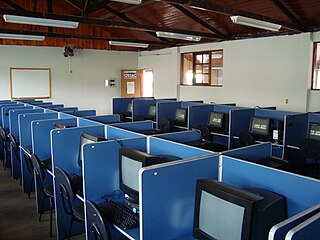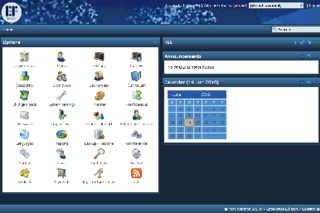Computer-assisted language learning (CALL), known as computer-aided instruction (CAI) in British English and computer-aided language instruction (CALI) in American English, Levy briefly defines it as "the exploration and study of computer applications in language teaching and learning." CALL embraces a wide range of information and communications technology "applications and approaches to teaching and learning foreign languages, ranging from the traditional drill-and-practice programs that characterized CALL in the 1960s and 1970s to more recent manifestations of CALL, such as those utilized virtual learning environment and Web-based distance learning. It also extends to the use of corpora and concordancers, interactive whiteboards, computer-mediated communication (CMC), language learning in virtual worlds, and mobile-assisted language learning (MALL).
Educational software is a term used for any computer software that is made for an educational purpose. It encompasses different ranges from language learning software to classroom management software to reference software. The purpose of all this software is to make some part of education more effective and efficient.
Moodle is a free and open-source learning management system written in PHP and distributed under the GNU General Public License. Moodle is used for blended learning, distance education, flipped classroom and other online learning projects in schools, universities, workplaces and other sectors.
Blended learning or hybrid learning, also known as technology-mediated instruction, web-enhanced instruction, or mixed-mode instruction, is an approach to education that combines online educational materials and opportunities for interaction online with physical place-based classroom methods.

Asynchronous learning is a general term used to describe forms of education, instruction, and learning that do not occur in the same place or at the same time. It uses resources that facilitate information sharing outside the constraints of time and place among a network of people. In many instances, well-constructed asynchronous learning is based on constructivist theory, a student-centered approach that emphasizes the importance of peer-to-peer interactions. This approach combines self-study with asynchronous interactions to promote learning, and it can be used to facilitate learning in traditional on-campus education, distance education, and continuing education. This combined network of learners and the electronic network in which they communicate are referred to as an asynchronous learning network.
Educational technology is the combined use of computer hardware, software, and educational theory and practice to facilitate learning. When referred to with its abbreviation, "EdTech", it often refers to the industry of companies that create educational technology. In EdTech Inc.: Selling, Automating and Globalizing Higher Education in the Digital Age, Tanner Mirrlees and Shahid Alvi (2019) argue "EdTech is no exception to industry ownership and market rules" and "define the EdTech industries as all the privately owned companies currently involved in the financing, production and distribution of commercial hardware, software, cultural goods, services and platforms for the educational market with the goal of turning a profit. Many of these companies are US-based and rapidly expanding into educational markets across North America, and increasingly growing all over the world."
A virtual campus or e campus, refers to the online offerings of a college or university where college work is completed either partially or wholly online, often with the assistance of the teacher, professor, or teaching assistant. Many colleges and universities now offer such courses either partially or wholly online. There are an estimated 4,500 such institutions with total enrollments approaching perhaps 2 million.

ATutor is an open source web-based learning management system (LMS).
Technology integration is defined as the use of technology to enhance and support the educational environment. Technology integration in the classroom can also support classroom instruction by creating opportunities for students to complete assignments on the computer rather than with normal pencil and paper. In a larger sense, technology integration can also refer to the use of an integration platform and application programming interface (API) in the management of a school, to integrate disparate SaaS applications, databases, and programs used by an educational institution so that their data can be shared in real-time across all systems on campus, thus supporting students' education by improving data quality and access for faculty and staff.
"Curriculum integration with the use of technology involves the infusion of technology as a tool to enhance the learning in a content area or multidisciplinary setting... Effective technology integration is achieved when students can select technology tools to help them obtain information on time, analyze and synthesize it, and present it professionally to an authentic audience. Technology should become an integral part of how the classroom functions—as accessible as all other classroom tools. The focus in each lesson or unit is the curriculum outcome, not the technology."
Computer-supported collaborative learning (CSCL) is a pedagogical approach wherein learning takes place via social interaction using a computer or through the Internet. This kind of learning is characterized by the sharing and construction of knowledge among participants using technology as their primary means of communication or as a common resource. CSCL can be implemented in online and classroom learning environments and can take place synchronously or asynchronously.
In the history of virtual learning environments, the 1990s was a time of growth, primarily due to the advent of the affordable computer and of the Internet.
E-learning theory describes the cognitive science principles of effective multimedia learning using electronic educational technology.
The Advanced Distributed Learning (ADL) Initiative is a US government program that conducts research and development on distributed learning and coordinates related efforts broadly across public and private organizations. ADL reports to the Defense Human Resources Activity (DHRA), under the Director, DHRA. Although it is a DoD program, ADL serves the entire US federal government, operates a global partnership network including international defense ministries and US-based academic partners, and collaborates closely with industry and academia. ADL advises the DoD and US government on emerging learning technologies, best practices for improving learning effectiveness and efficiency, and methods for enhancing interoperability. Notable ADL contributions to distributed learning include the Sharable Content Object Reference Model (SCORM), Experience API (xAPI), and the DoD Instruction 1322.26.
Online tutoring is the process of tutoring in an online, virtual, or networked, environment, in which teachers and learners participate from separate physical locations. Aside from space, participants can also be separated by time.

A Virtual Learning Environment (VLE) is a system specifically designed to facilitate the management of educational courses by teachers for their students. It predominantly relies on computer hardware and software, enabling distance learning. In North America, this concept is commonly denoted as a "Learning Management System" (LMS).

eFront is an eLearning platform (also known as a Course Management System, or Learning Management Systems, or Virtual Learning Environment ). eFront has historically been coming in a number of editions, from an open-source edition to the latest eFrontPro edition.
Online communication between home and school is the use of digital telecommunication to convey information and ideas between teachers, students, parents, and school administrators. As the use of e-mail and the internet becomes even more widespread, these tools become more valuable and useful in education for the purposes of increasing learning for students, and facilitating conversations between students, parents, and schools.
Educational data mining (EDM) is a research field concerned with the application of data mining, machine learning and statistics to information generated from educational settings. At a high level, the field seeks to develop and improve methods for exploring this data, which often has multiple levels of meaningful hierarchy, in order to discover new insights about how people learn in the context of such settings. In doing so, EDM has contributed to theories of learning investigated by researchers in educational psychology and the learning sciences. The field is closely tied to that of learning analytics, and the two have been compared and contrasted.

Online learning involves courses offered by primary institutions that are 100% virtual. Online learning, or virtual classes offered over the internet, is contrasted with traditional courses taken in a brick-and-mortar school building. It is a development in distance education that expanded in the 1990s with the spread of the commercial Internet and the World Wide Web. The learner experience is typically asynchronous but may also incorporate synchronous elements. The vast majority of institutions utilize a learning management system for the administration of online courses. As theories of distance education evolve, digital technologies to support learning and pedagogy continue to transform as well.

Digital media in education refers to an individual's ability to access, analyze, evaluate, and create media content and communication in various forms. This includes the use of multiple digital softwares, devices, and platforms as tools for learning. The integration of digital media in education has been increased over time, rivaling books as a primary means of communication and gradually transforming traditional educational practices.





